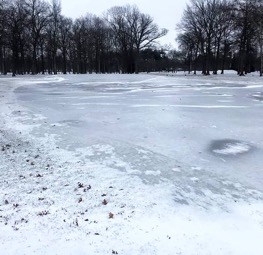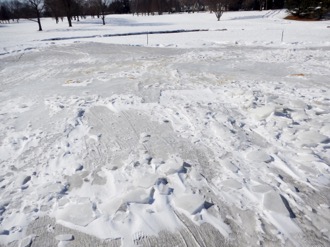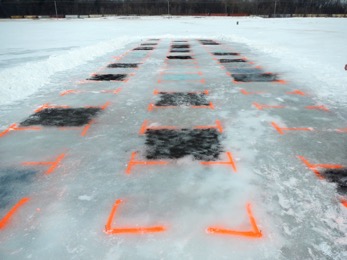
Golf course superintendents across the north are dealing with ice cover on putting greens and deciding what actions to take to ensure turfgrass survival.
February 13, 2019 – Author: Kevin Frank, Michigan State University Extension, Department of Plant, Soil and Microbial Sciences
Recent ice formation at Saginaw Country Club. Photo by Rob Steger.
Here in mid-Michigan, winter was late to arrive but has certainly made its presence felt in the last several weeks. However, from Minnesota to Ontario, I’ve been fielding questions since mid-December on ice cover on putting greens and what should or should not be done. This winter has been characterized by drastic swings in temperatures that have resulted in numerous melting and refreezing events and there have been ice storms mixed in for good measure that greeted some superintendents upon returning from the Golf Industry Show in San Diego, California.
As we approach the middle of February, there is both good and bad to be recognized with this date. The key question for anyone dealing with ice is when did you start your ice clock? Many superintendents vividly remember the winter of 2013-2014 that resulted in thick ice sheets remaining in place for up to 80 days in some locations. That winter produced ice on putting greens the first week of January and it never melted until March, which resulted in death from anoxia (suffocation).
Remember, estimates of days of ice cover causing death for annual bluegrass range from 45-90 days and 120 days for creeping bentgrass. Just last year some locations in northern Minnesota suffered over 150 days of ice cover that killed not only annual bluegrass but also creeping bentgrass.
So when did your clock start? If your ice clock only recently started, I would have minimal concern in most areas as it is likely Mother Nature will “help the melt” before you reach 30-45 days of ice cover. If your ice clock started in early December and cover has been constant, then the turf is in the danger zone of life/death and it’s probably time to consider removal strategies.
Removing Ice
Whether or not to attempt ice removal is a difficult decision for golf course superintendents. The decision to remove ice can be based on several factors, including turf sampling, duration of ice cover, current and future temperatures, ability to remove water following melting from the green, and labor.
Sampling. There’s a great YouTube video from Bob Vavrek of the USGA on how to sample greens under ice to assess survival. An important point that Vavrek makes is that there is variability in sampling and just because your sample comes out alive doesn’t mean all areas on the green will survive—same can be said if your sample is dead.
Duration of ice cover. As discussed in the previous section, estimates of days of ice cover causing death vary from 45-90 for Poa annua and 120 days for creeping bentgrass. Check your ice clock and proceed accordingly.
Temperatures and sunshine. Check your local forecast for temperatures and hopefully sunshine that will facilitate ice removal and melt. Part of the concern with removing ice is exposing the turf to cold air temperatures after being insulated with snow and ice for long periods of time. In the past, some superintendents have removed ice and then recovered the greens with snow to provide insulation against cold temperatures.

Physical ice removal. Physical ice removal includes practices to fracture the ice with impact (hammers, chisels, aerifiers, slicers) and then remove the fractured ice sheet with shovels, tractors or skid steers. Avoid direct impact with tools such as hammers—I’ve seen superintendents use a vibratory tamp with good results as it minimizes direct impact when shattering the ice. There’s always some risk associated with impact related ice removal, but the alternative of leaving ice in place and rolling the dice on survival is also risky.
Melting ice. There are many different products that have been used to melt ice including black sand, dark-colored natural organic fertilizers, sunflower seeds and fertilizers. The key to any melting strategy is to be able to remove the water from the green following melting so it doesn’t refreeze and form another ice sheet.
Hollman et al. (2017) published an article on the “Effects of De-Icing Products on Putting Green Turf.” The results indicated that urea-based chemicals have the potential to severely damage turfgrass when applied to snow/ice free turf in early March. We applied these same treatments at Michigan State University in 2014 to an ice-covered putting green, but were unable to assess turfgrass injury as all the turfgrass was dead by the time the ice receded. A YouTube video of this trial.

My simple message to selecting melt materials is keep in mind that whatever you apply will ultimately end up on the turf. If you don’t feel comfortable applying it to turf, that should tell you something about applying it to ice.
Labor. If you’re going to remove ice, you need help. Ice removal is not a one-person job. If your golf course has 18 greens covered in ice even with several employees helping, this is not going to be finished in one day.
There are few guarantees in life or ice cover.
There are no guarantees with respect to winterkill and whether ice removed will save the turf. The days under ice cover for survival are estimates from research and conditions from course to course and even within the same course vary, thereby affecting how long turf can survive under ice. For further winterkill information or if you simply want to view some great winterkill death photos, there’s a complete winterkill presentation on YouTube from the Great Lakes School of Turfgrass Science


